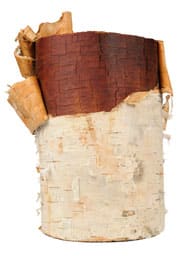
They range from attractive colors to bark that has interesting quilt-like patterns to those that are exfoliating or peeling.
Crape myrtles are prized for their colorful summer flowers. They have bark that peels and ranges in color from tan to gray to cinnamon. Properly pruned crape myrtles have a sculpture-like appearance. They are hardy trees that can tolerate temperatures extremes, but they do require sites with full sun and well-drained soils.

The river birch is commonly planted in landscapes. It has bark that exfoliates into papery plates that expose inner bark. The different cultivars of river birches have a variety of bark colors that range from gray to brown to red to salmon pink. The exfoliating characteristics occur on branches as small as two inches wide. The older bark on the trunk and larger branches develops a dark brown color with ridges and furrows. The shedding of the bark can be excessive at times and that, along with the fact the tree drops leaves and branches continually, suggests that it should be planted in areas where the debris will not be troublesome.
Lacebarks elms thrive in our area and do well when planted beside streets and walkways. They have bark that has an attractive combination of gray, green, orange and brown. The trees grow at a fast rate and have a broad canopy which creates dappled shade beneath.
Japanese Stewartias are not commonly used but have excellent characteristics. The trees have smooth bark that flakes off exposing inner bark that is orange, gray, tan and green. The bark pattern becomes more attractive as the trees age. The trees produce flowers during the summer that are white and resemble camellia blooms.
When we think of dogwoods, we envision trees with colorful blooms in the spring. However, several other lesser known species of dogwoods, such as the Tatarian dogwood, the pagoda dogwood, and the red osier dogwood, are low growing and have colorful red to yellow branches and stems that brighten the winter landscape. The trees provide color to the dull winter landscape.
Although we are in the dead of winter, several plants can beautify the landscape with their colorful bark. Consider planting some to add beauty to your yard.
Timothy Daly, is an Agricultural and Natural Resource Extension Agent with Gwinnett County. He can be contacted at 678-377-4010 or tdaly@uga.edu

